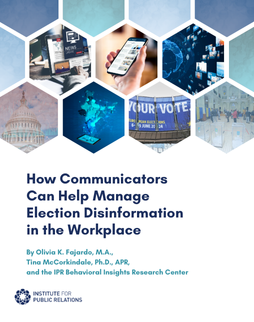This blog is provided by IPR based on the original study in Public Relations Review
The COVID-19 pandemic has led to new lessons in health communication. Particularly, misinformation has spread through social media, driving some communities to engage in risky behaviors. For that reason, it is critical for public health messages to motivate members of the public to take appropriate protective actions while safeguarding against unintended consequences.
Our research team conducted a survey (prior to the COVID-19 pandemic) with more than 1,000 U.S. adults. Our goal was to understand the factors that lead people to seek infectious disease outbreak information in the media and to subsequently adopt recommended protective actions.
We found that efficacy-increasing, empowerment-embedded messages are the keys to motivate members of the public to comply with official guidelines for protective behaviors. In terms of effective message design, our study recommends that health communicators:
- Be mindful of communities potentially vulnerable to misinformation. Survey participants with lower outbreak literacy, or those who experience more difficulty understanding infectious disease outbreak information, were more likely to use various channels to look for outbreak information, compared to those with higher outbreak literacy. The channels sought by those with low outbreak literacy (e.g., friends, family, social media users) are not necessarily credible sources of health information. This suggests that people with low outbreak literacy may be more vulnerable to misinformation spread through word of mouth and social media. Tailoring outbreak messages at various and appropriate literacy levels is critical for message success while constantly debunking and correcting emerging misinformation.
- Make doable and feasible recommendations. Participants with higher outbreak efficacy, or those who believe that they can take appropriate steps to protect themselves, were more likely to report that they would follow health authorities’ recommended protective actions, compared to those with lower outbreak efficacy. Official guidelines and recommendations need to be relatively easy to follow and not communicated in a manner that is unnecessarily complex. Also, if a recommendation requires a course of actions (e.g., initiating and completing a vaccination series) or involves potential difficulties (e.g., mask shortage), proper explanations and/or solutions must be provided.
- Communicate the health authority’s competency in crisis management. Participants with higher organizational efficacy, or those who are more confident about health authorities’ knowledge and ability to manage outbreaks, were more likely to report that they would comply with recommended protective actions. Public health authorities should communicate, to the extent possible, that they are in control and have adequate resources to manage outbreaks. When people process authorities’ messages, they need to believe that the authorities are providing as much information as possible to help guide public responses.
People build confidence about themselves or others as they observe successful performance of safety behaviors over time. In that sense, health authorities should actively communicate their outbreak management successes, while recognizing missteps, along with a commitment to public health. Keeping the public updated about the latest developments during an outbreak and how public authorities are responding can help build public trust in authorities and perceptions of high organizational efficacy.
We recommend that message design guidance provided by tools such as the CDC’s Clear Communication Index (CCI) be expanded to include measures of individuals’ outbreak efficacy and organizational efficacy. Training, such as the CDC’s Crisis and Emergency Risk Communication (CERC) program, also could be updated to consider outbreak and organizational efficacies. Understanding audiences’ varied levels of outbreak efficacy and confidence in authorities is essential for helping communities keep themselves safe during infectious disease outbreaks.
Seoyeon Kim (Ph.D., University of North Carolina at Chapel Hill) is an assistant professor of advertising and public relations at the University of Alabama. Her research focuses on public relations, corporate social responsibility communication, and health/crisis communication.
Lucinda Austin (Ph.D., University of Maryland) is an associate professor at the Hussman School of Journalism and Media at the University of North Carolina at Chapel Hill. Austin’s research focuses on social media’s influence on strategic communication initiatives and explores audiences’ perspectives in corporate social responsibility and organization-public relationship building.
Brooke Fisher Liu (Ph.D., University of North Carolina at Chapel Hill) is a professor of communication at the University of Maryland. Her research investigates how government messages, media, and interpersonal communication can motivate people to successfully respond to and recover from disasters.
Yan Jin (Ph.D., University of Missouri) is a professor of public relations and the Athletic Association Professor in the Grady College of Journalism and Mass Communication at the University of Georgia. Her research programs focus on crisis and risk communication and strategic conflict management in a rapidly evolving media landscape and amidst emotionally charged challenging situations, ranging from organizational crises to public health emergencies.



